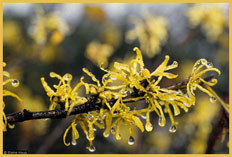TREE TALK
Originally published in Capital on March 8, 2008

According to the trees...
Spring is Here
Spring is here, maybe not according to the calendar, but the trees seem to know when it’s time to start growing again without being told to by humans. When compared to how long trees have been living on this planet, calendars were just invented yesterday. Maybe they could teach us a few things about time and patience. We’ll get back to that at a later date. Now back to spring.
Once the days lengthen and the days warm up, trees and other woody plants are among the first plants to start flowering. A question I get asked from time to time is: "Why some trees flower before they put out their leaves? " And a good question it is, too. Growing flowers takes a lot of energy, and uses up a lot of the stored food reserves a tree has. But, so does ‘flushing out’ a set of leaves; in fact more, since they are larger and more of them. Logically one might ask if the leaves were in place and producing food before the flowers come out wouldn’t that help the tree out? Yes and no, is the answer here; yes it would help in the food department but in the pollination effort it would hinder movement of the air that spreads the pollen around.
A tree's canopy as we know makes a very effective windbreak. Within the canopy of the tree air movement is restricted quite effectively by the leaves. Some air moves through of course but on days when the winds are light, air movement within a dense canopy will be almost nil. The most notable trees that flower first in this area are the maples and oaks which are common in the forest, and used extensively as street and shade trees. Other trees produce flowers around the same time as leaves are formed such as tulip poplar, while a few trees and shrubs, mostly ornamentals from other areas of the country, flower in late summer and fall, notably witch hazel.
Witch hazel, which is more of a piedmont and mountain species, can be very showy when growing in the understory of a beech forest. Witch hazel's yellow flowers contrast well against the coppery brown fall leaves of the Beech. So some trees are in full bloom right now, much to the chagrin of allergy sufferers, but a positive indicator spring is finally here.
On a general note, now is a good time to start attacking the invasive vines that are infesting the region. Poison ivy is still dormant too so there is less chance of getting exposed. The dormant vines if cut or damaged so that the sap is exposed can still give you a full blown rash so be careful when handling the dormant vines.
Mechanical control of vines like English Ivy and oriental bittersweet can be very effective at this time. The vines should be pulled up and either sent to the landfill, or allowed to dry so the plant is completely dead. If you pull English ivy and throw it back on the ground it will likely take root and start growing there; so basically you just changed its location and you are back to square one.
Once the ivy is mostly gone you can watch for new growth and then you can effectively treat with an appropriate herbicide.
For more information you can request a DVD on Invasive Species control from the Anne Arundel Forestry Board at the email address below. Also if you would like to go to an invasive species control workshop geared for homeowners and forest landowners there is one scheduled for April 19 in Baltimore County. Send an email for registration information.
Questions and comments can be directed to
ForestGreenway@comcast.net
Bud Reaves writes Tree Talk for the Anne Arundel County Forest Conservancy
District Board.
Photograph of American Witch Hazel in flower, Elaine Haug @ USDA-NRCS PLANTS Database, photograph by Elaine Haug courtesy of Smithsonian Institution.
Additional Forestry-Related Links
Champion Trees of Anne Arundel County
Big Tree Champions of Maryland
Native Plants for Anne Arundel County
Planting and Care of Your Trees
TREE-MENDOUS MARYLAND
Invasive Species